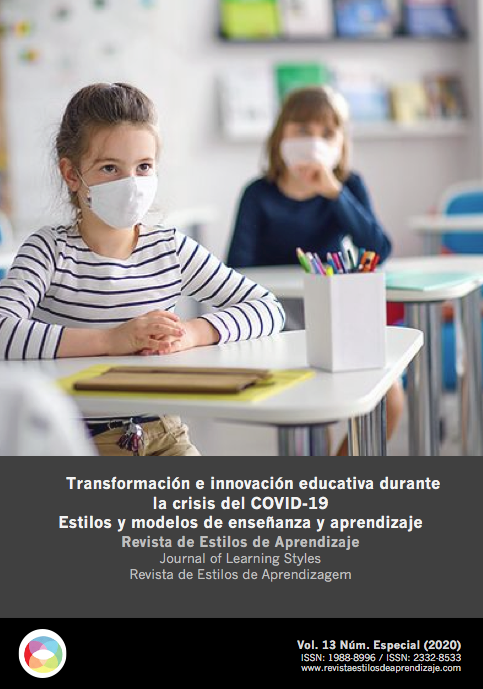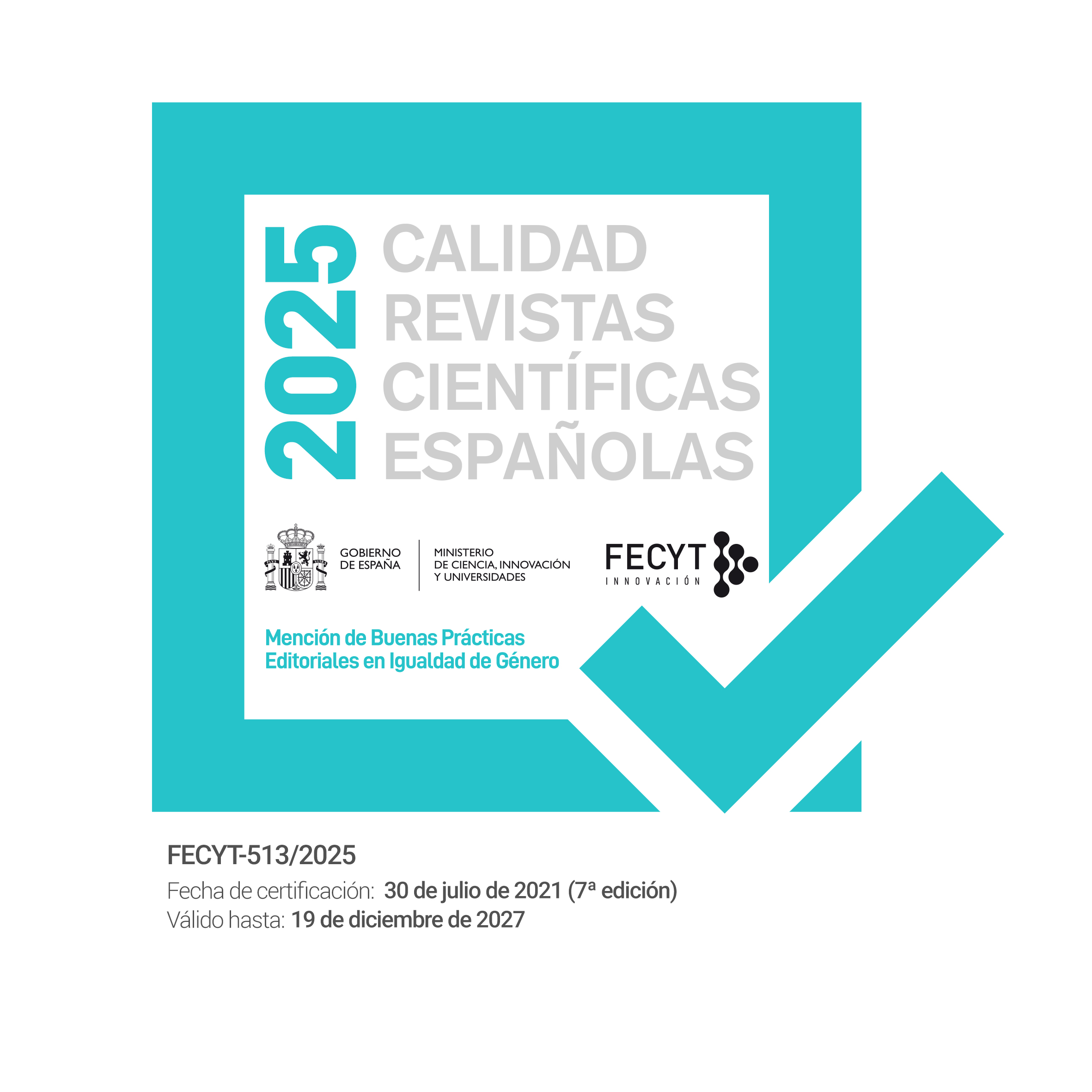Self-perception of the learning experience in the virtual environment in young university students with intellectual disabilities
DOI:
https://doi.org/10.55777/rea.v13iEspecial.2243Keywords:
SARS-Cov-19, Intellectual Disability, University, Virtual Spaces, InclusionAbstract
At the moment we are living it is urgent to give an inclusive response to the most vulnerable groups. The pandemic associated with SARS-Cov-19, declared by the World Health Organization (WHO), sets an unprecedented scenario for people with intellectual disabilities (ID). Various studies carried out for this purpose already identify, among other associated variables, an emotional imbalance and behavioral changes that originate due to the crisis and social isolation (Morales-Chávez, 2020). A quantitative study is presented as an exploratory study. An ad hoc instrument has been designed for a group of 14 young university students between the ages of 20 and 26, most of whom are men (71.4%) with ID. According to Hernández and Ortega (2016), the relevance of this topic is justified by the scarce presence in the scientific literature of research on inclusive education in virtual environments. The results obtained allow the perceived well-being and we can affirm that the climate generated seem to have reduced the states of reluctance, anxiety and frustration of the students, in a unique university experiential moment. The quantitative analysis, reflected in descriptive results, will allow decisions to be made about the actions that should be considered as continuous improvement of the teaching-learning process in virtual spaces, a necessary measure to be considered in the response to attention to diversity.
Downloads
References
Asín Cala, E., Stewart Santos, M. Parra Pérez, K.M. (2020). Importancia del plan de acción tutorial en la educación a distancia. Revista de Investigación, Formación y Desarrollo: Generando Productividad Institucional,8 (1), 30-39. Recuperado de: https://doi.org/10.34070/rif.v7i1
Benavidez Torres, F. y Vásquez-Benítez, L. (2019). La importancia de la gestión curricular universitaria en programas a distancia, estudio institución de educación superior suramericana. In Crescendo, 10(1), 13-34. DOI: http://dx.doi.org/10.21895/incres
Booth, T. y Ainscow. A. (2011). Index for inclusion: developing learning and participation in schools. Bristol: Centre for Studies on Inclusive Education.
Bryant, B.R., Rao, K. y Ok, M.W. (2014). Universal design for learning and assistive technology. Advances in Medical disabilities: An evidence-based systematic review and meta-analysis. Computers & Education, 114, 139-163, DOI: http://doi:10.4018/978-1-4666-5015-2.ch002
Caro, E. M. (2008). E-learning: un análisis desde el punto de vista del alumno. RIED: Revista iberoamericana de educación a distancia, 11(2), 151-168. DOI: https://doi.org/10.5944/ried.2.11.948
Casasola Balsells, L. A., Guerra González, J. C., Casasola Balsells, M. A., Pérez Chamorro, V. A. (2017). La accesibilidad de los portales web de las universidades públicas andaluzas. Revista Española de Documentación Científica, 40(2), 169. DOI: http://dx.doi.org/10.3989/redc.2017.2.1372
Catuogno, A. y González, C. (2006). Educación Virtual en la escuela media. Guía para el docente. Buenos Aires: Nueva Generación.
Cerrillo Martín, C., Izuzquiza Gasset, D. y Egido Gálvez, I. (2013). Inclusión de jóvenes con discapacidad intelectual en la Universidad, Revista de Investigación en Educación, 11 (1), 41-57. http://reined.webs.uvigo.es/index.php/reined/article/view/161. [Consulta: 6-6-2020]
Chiner, E., Gómez-Puerta, M. y Cardona-Moltó, M. C. (2017). Internet and people with intellectual disability: an approach to caregivers’ concerns, prevention strategies and training needs, Journal of new approaches in educational research, 6(2), 153–158. DOI: https://doi.org/10.7821/naer.2017.7.243
Copper, M. (2006). Making online learning accessible to disabled students: An institutional case study. Research in Learning Technology, 14 (1), 103-115. DOI: https://doi.org/10.3402/rlt.v14i1.10936
Cuevas Cerveró, A., Razquin Zazpe, P., Parra Valero, P., Barrios Martínez, C. y Gómez-Hernández, J. A. (2019). Accesibilidad informacional y diversidad funcional en el contexto universitario: el caso de la Universidad Complutense de Madrid. En Compêtencia em informação e políticas para a educação superior: Estudos Hispano-Brasileiros. Facultad de Documentación, Universidad Complutense de Madrid, 132-146.
Del Río, A. Z. y Pastor, C. A. (2013). Disability in the Perception of Technology among University Students. Comunicar: Revista Científica de Comunicación y Educación, 20(40), 165-172. DOI: https://doi.org/10.3916/C40-2013-03-07
Díaz Gandasegui, V. (2013). Entornos virtuales para el desarrollo de la educación inclusiva: Una mirada hacia el futuro desde el pasado de Second Life. Revista Latinoamericana de Tecnología Educativa, 12(2), 67-77. https://relatec.unex.es/article/view/1105/803 [Consulta: 6-6-2020]
Díez-Gutiérrez, E., & Díaz-Nafría, J.M. (2018). Ubiquitous learning ecologies for a critical cybercitizenship. [Ecologías de aprendizaje ubicuo para la ciberciudadanía crítica]. Comunicar, 26, 49-58. DOI: https://doi.org/10.3916/c54-2018-05
Fernández Maíllo, G. (2020). La gran desvinculación, el resultado final de un modelo de desarrollo social, Anales de derecho y discapacidad, 5, 185-202. https://www.cermi.es/sites/default/files/docs/colecciones/Anales%20V%5B57964%5D.pdf [Consulta: 6-6-2020]
Fundación Vodafone (Ed.) (2013). Acceso y uso de las TIC por las personas con discapacidad. Conclusiones y resumen ejecutivo. Fundación Vodafone España. Obtenido el 08/06/2020 Recuperado de: https://www.aspaym.org/pdf/publicaciones/Acceso%20y%20uso%20de%20las%20TIC%20por%20las%20personas%20con%20discapacidad.pdf
García-Monge, A., González-Calvo, G. Martínez-Álvarez, L. y Rodríguez-Campazas, H. (2020). Aula extendida: acercando el aula universitaria a los contextos escolares para reducir la distancia «teoría-práctica», RETOS. Nuevas tendencias en Educación Física, Deporte y Recreación, 37, (1º), 563- 571. https://recyt.fecyt.es/index.php/retos/article/view/74168/45722 [Consulta: 6-6-2020]
Grzona, M. (2014). La accesibilidad educativa en las aulas inclusivas. Una mirada didáctica. Investigación y Postgrado, 29(2), 137-149. https://www.redalyc.org/pdf/658/65848281007.pdf [Consulta: 6-6-2020]
Gutiérrez, P., & Martorell, A. (2011). People with intellectual disability and ICTs. [Las personas con discapacidad intelectual ante las TIC]. Comunicar, 18, 173-180. DOI: https://doi.org/10.3916/C36-2011-03-09
Hernández Sánchez, A. M., & Ortega Carrillo, J. A. (2016). Percepción de bienestar en experiencias inclusivas de blended learning. Educatio Siglo XXI, 34(2 Julio), 63-82. DOI: https://doi.org/10.6018/j/263811
Hernández-Sánchez, A. M. y Ortega, J. A. (2015). Aprendizaje electrónico afectivo: un modelo innovador para desarrollar una acción tutorial virtual de naturaleza inclusiva. Formación Universitaria, 2 (VIII), 19-26. https://scielo.conicyt.cl/pdf/formuniv/v8n2/art04.pdf [Consulta: 6-6-2020]
Kieser, A. L. y Ortiz-Golden, F. (2009). Using Online Office Applications: Collaboration Tools for Learning. Distance Learning, 6, (1), 41-46. http://citeseerx.ist.psu.edu/viewdoc/download?doi=10.1.1.363.9334&rep=rep1&type=pdf#page=45 [Consulta: 6-6-2020]
Ley 2/2013, de 15 de mayo, de Igualdad de Oportunidades para las Personas con Discapacidad. «BOE» núm. 135, de 6 de junio de 2013. Recuperado de: https://www.boe.es/diario_boe/txt.php?id=BOE-A-2013-5998
Ley Orgánica 6/2001, de 21 de diciembre, de Universidades «BOE» núm. 307, de 24 de diciembre de 2001. Recuperado de: https://www.boe.es/eli/es/lo/2001/12/21/6
Lezcano, L., y Vilanova, G. (2017). Instrumentos de evaluación de aprendizaje en entornos virtuales. Perspectiva de estudiantes y aportes de docentes. Informes Científicos Técnicos-UNPA, 9(1), 1-36.
Mampaso Desbrow, J. y Carrascal Domínguez, S. (2020). El espacio como elemento facilitador del aprendizaje y de atención a la diversidad. Revista De Estilos De Aprendizaje, 13(25), 1-3. Recuperado de: http://revistaestilosdeaprendizaje.com/article/view/2092
Medina-Gómez, B. y Gil-Ibáñez, R. (2017). Estrés y estrategias de afrontamiento en personas con discapacidad intelectual: revisión sistemática. Ansiedad y Estrés, 23, 38-44. DOI: http://dx.doi.org/10.1016/j.anyes.2017.05.001
Morales-Chávez. M. (2020). Coronavirus y discapacidad. Una población muy vulnerable. Acta odontológica venezolana. Recuperado de: https://www.actaodontologica.com/ediciones/2020/especial/art-5/
Negrón, S. (2019). Influencia de la cultura organizacional Universitaria en el Uso de las tic. Revista Electrónica de Investigación y Docencia, 21, 67-80. https://doi.org/10.17561/reid.n21.5 Recuperado de: https://revistaselectronicas.ujaen.es/index.php/reid/article/view/3962/3789
Observatorio de Accesibilidad TIC de Discapnet (Portal de personas con discapacidad) (2010). Accesibilidad de portales web universitarios. Recuperado de: https://www.discapnet.es/sites/default/files/areas-tematicas/tecnologia/acces_portales_web_universitarios_detallado.pdf [Consulta: 6-6-2020]
Observatorio de Accesibilidad TIC de Discapnet (Portal de personas con discapacidad). (2010). Accesibilidad de portales web universitarios. Recuperado de: https://www.discapnet.es/sites/default/files/areas-tematicas/tecnologia/acces_portales_web_universitarios_detallado.pdf [Consulta: 6-6-2020]
Observatorio sobre Discapacidad y Mercado de Trabajo de la Fundación ONCE ODISMET, Observatorio sobre discapacidad y mercado de trabajo en España; (2016), Recuperado de: https://www.odismet.es/sites/default/files/import/reports_and_publications/27_2.pdf
Perelmutter, B., Mcgregor, K.K. y Gordon, K.R. (2017). Assistive technology interventions for adolescents and adults with learning disabilities: An evidence-based systematic review and meta-analysis. Computers & Education, 114, 139-163. DOI: https://doi.org/10.1016/j.compedu.2017.06.005
Rodrigo, C. y Tabuenca, B. (2020). Ecologías de aprendizaje en estudiantes online con discapacidades. Comunicar: Revista científica iberoamericana de comunicación y educación, (62), 53-65, DOI: https://doi.org/10.3916/C62-2020-05
Rodríguez, A. L., Lozano, D. E. V., Aradillas, A. L. S., & Duque, E. E. (2011). Uso de Google Docs como herramienta de construcción colaborativa tomando en cuenta los estilos de aprendizaje. Revista de Estilos de Aprendizaje, 4(8). 23-39. Recuperado de: http://revistaestilosdeaprendizaje.com/article/view/934
Scott, H. M. y Havercamp, S. M. (2014). Mental health for people with intellectual disability: The impact of stress and social support. American Journal on Intellectual and Developmental Disabilities, 119, 552-564. https://nisonger.osu.edu/wp-content/uploads/2019/01/Scott-Havercamp-2014.pdf [Consulta: 6-6-2020]
Segovia, C. (2007). Accesibilidad e Internet... para que todas las personas con distintas capacidades y recursos puedan acceder a Internet. Madrid: SIDAR. Recuperado de: http://sid.usal.es/idocs/F8/FDO19018/accesibilidadeinternet.pdf [Consulta: 6 -6-2020].
Tabuenca, B., Ternier, S. y Specht, M. (2013). Supporting lifelong learners to build personal learning ecologies in daily physical, Technologies and Clinical Practice, 11-26. DOI: https://doi.org/10.4018/978-1-4666-5015-2.ch002
UNESCO (2008). La Educación inclusiva: el camino hacia el futuro. Conferencia Internacional de Educación, cuadragésima octava reunión, Centro Internacional de Conferencias. Recuperado de: http://www.ibe.unesco.org/fileadmin/user_upload/
Vanegas, C. A. y Pinzón, S. A. (2014). Accesibilidad en el diseño de páginas web. Revista vínculos, 9(2), 177-190. Recuperado de: http://riberdis.cedd.net/bitstream/handle/11181/4069/Accesibilidad_en_el_dise%c3%b1o_de_p%c3%a1ginas_web.pdf?sequence=1&rd=0031378195228240
Vásquez Aguilar, D.V., Soto Chávez, L.E., Allauca Amaguaya, M. y Benitez Troya, F.A. (2020). Aprendizaje inclusivo para las personas con discapacidad, RECIMUNDO, 4 (1Esp), 182-190. DOI: https://doi.org/10.26820/recimundo/4.(1).esp.marzo.2020,182-190.
Víquez-Alfaro, C., López-Garbanzo, L., Cordero-Salas, M. y Alpízar-Alfaro, P. (2019). Fortalecimiento de la autonomía de jóvenes con discapacidad intelectual mediante la aplicación de las TIC, Innovaciones educativas, 30, 48- 61. DOI: https://doi.org/10.22458/ie.v21i30.2484
Virtanen, M.A., Haavisto, E., Liikanen, E. y Kääriäinen, M. (2018). Ubiquitous learning environments in higher education: A scoping literature review. Education and Information Technologies, 23(2), 985-998. DOI: https://doi.org/10.3916/C62-2020-05
W3C (2008). Web Content Accessibility Guidelines (WCAG) 2.0. Recuperado de: http://www.w3.org/TR/WCAG/
Williams, P., Jamali, H.R., & Nicholas, D. (2006). Using ICT with people with special education needs: What the literature tells us. Aslib Proceedings, 58(4), 330-345. DOI: https://doi.org/10.1108/00012530610687704
Downloads
Published
How to Cite
Issue
Section
License
By submitting the original, the author(s) declare that they are aware of and accept, in full, the privacy policy as well as the copyright of the Learning Styles Magazine.
The Learning Styles Magazine offers free and open access to its content, completely free of charge, in order to bring scientific research to its readers and society in general. All digital contents are free and open access and are published under a Creative Commons license:

Rights are granted under the Creative Commons Reconocimiento-NoComercial-SinObraDerivada 4.0 Internacional (CC-BY-NC-ND 4.0)
The Learning Styles Magazine is an open access journal. Publication of articles or reviews in the Journal does not entitle you to any remuneration. For authors as well as readers, the journal is free Creative Commons Reconocimiento-NoComercial-SinObraDerivada 4.0 Internacional (CC-BY-NC-ND 4.0).
With this licence, the reproduction and dissemination of the contents of the magazine for educational, social and knowledge transmission purposes is permitted, without any profit motive in mind, provided that the source and authorship are not modified. The licence granted to Learning Styles Magazine allows the copying and distribution of the magazine's contents, as long as the authorship of the work is recognised, correctly specifying the author and the publishing entity. The work may not be used for commercial purposes, nor may it be altered, transformed or generated from this work.
The publication of articles or reviews in the Journal does not give the right to any remuneration.
The Learning Styles Journal invites the author/authors to increase the visibility and scope of their articles published by re-disseminating them in:
- Web spaces and personal networks, as well as in scientific meetings and forums
- Open institutional archives in Universities, educational repositories and Research Centres.
- Academic and scientific networks (Researchgate, Academia.edu, Plubons, etc.)
All these spaces and publications must include all the bibliographic data of the publication.

























